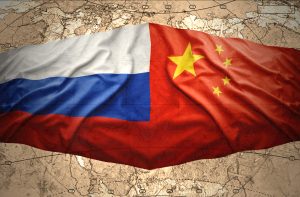At the end of July 2023, China and Russia conducted joint military exercises in the Sea of Japan. China’s People’s Liberation Army (PLA) might have taken advantage of the exercises to put into practice some lessons the PLA has learned from the ongoing Russia-Ukraine war, in particular how to respond to the undesired presence of U.S. military aircraft in the neighborhood.
The PLA has launched two rounds of large-scale military exercises around Taiwan since August 2022, with the most recent in April. During these two exercises, the PLA experienced intensive close-in reconnaissance by U.S. military aircraft, including P-8A anti-submarine warfare aircraft, E-3 early warning aircraft, and EC-135 electronic surveillance aircraft.
The situation in Ukraine is quite similar, with U.S. and NATO electronic surveillance and electronic warfare aircraft and drones flying in large numbers around the periphery of the war-ravaged country on a regular basis. These manned and unmanned aircraft provide Ukrainian troops with digital information that never stops coming in, dealing a blow to the morale of Russian invaders.
While Ukraine received some military aid from the United States before the start of the war, Taiwan has been a long-term user of U.S. weaponry, with much experience in integrating new weapon systems into existing ones and coordinating various types of platforms. Should an armed conflict break out in the Taiwan Strait, the interoperability between Taiwan’s military and its U.S. counterpart would surely be much better than the level seen in the Taiwan Strait Crisis of 1996. In the two large-scale military exercises held by the PLA around Taiwan in August 2022 and April 2023, there were many opportunities for Taiwan-U.S. information exchange and intelligence sharing.
In the future, the United States might not be directly involved in an armed conflict in the Taiwan Strait in the form of sending aircraft carriers and main fighting ships to the region. Instead, it could dispatch electronic warfare aircraft and electronic reconnaissance platforms to airspace and waters around Taiwan to provide support to Taiwan’s military. What the PLA most wants to know for the moment is how the Russian military has been able to overpower the U.S. in spectrum warfare, as has been seen on the battlefield of Ukraine. However, that is an invaluable lesson that the Russian military has learned the hard way.
Moreover, although the war in Ukraine is mainly a land war, the two sides still battled each other relatively intensively for control of the Black Sea. Ukrainian troops’ most representative achievement in these battles was the damage they brought to the fleet of the Russian Navy in the region using land-based weapons. There were no ship-to-ship engagements between the two sides, but how Ukraine used its shore-based weapons, drones, and electronic intelligence provided by the U.S. to launch effective strikes on Russian forces at sea is quite noteworthy.
Therefore, in its preparations for a potential invasion by the PLA in the not-too-distant future, Taiwan’s military aims to incrementally enhance its shore-based missiles and unmanned platforms in accordance with the “porcupine” strategy formulated by defense planners at home and abroad. The goal is to force the PLA to confront in the Taiwan Strait the same situation that the Russian military is faced with in the Black Sea.
Thus, how to absorb the Russian military’s combat experience in Ukraine is an important task for the PLA. Scenarios of this kind might have been enacted or brought to the foreground in the recent joint exercises between China and Russia in the Sea of Japan.
China is an important strategic partner for Russia, which, in the face of sanctions by the West, might have acquired from China quite a large quantity of equipment and spare parts for potential military use in the name of mutual cooperation between the two countries. Now that drones have become an invaluable asset on the modern battlefield, whether civilian drones manufactured in China would be provided in large quantities to Russia hangs in the balance. It also begs the question of whether the Russian military would gain access to the BeiDou navigation satellite system developed by China. Deeper cooperation along these lines would entail the possibility that China, in its pursuit of anti-ballistic missile technology, would learn from Russia important lessons that Moscow has accumulated in its long-term competition with the United States dating from the Cold War era.
In practice, space security and anti-ballistic missile exercises in the style of those previously launched could be further enhanced to help China and Russia have a better understanding of their respective relevant weapon systems and build a more solid basis for cooperation in this regard. This will be one of the key areas where the Chinese and Russian militaries will have many interactions in the years ahead, also helping the PLA learn from the war in Ukraine.

































